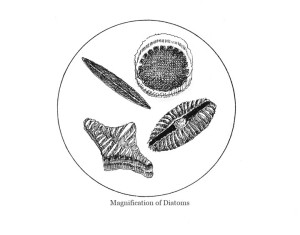
What is diatomaceous earth, you ask? Quite simply, it is the naturally occurring remains of Bacillariophyceae algae, unicellular organisms that have been abundant in the world’s oceans, lakes, and rivers for at least 135 million years. Algae in this class are known as diatoms, from the Greek word meaning “to cut in half,” a reference to the two-part shape of their shells.
Each diatom secretes a silica shell to protect itself during life. When the numerous organisms perish, their hard shells and innards fall to the muck at the bottom of the sea or body of water. Today, thick deposits of the hard shells can be found in old lake or sea beds, where they are mined for various uses. Although these deposits exist in many places throughout the world, most of the diatomaceous earth we see on store shelves in New Hampshire and Vermont was mined in California, Nevada, and the Pacific Northwest.
But that’s probably not why you asked. Instead, it’s the physical properties of diatomaceous earth that make it so interesting. Its porosity and absorptive abilities made it perfect for one of its early uses: as a stabilizer for nitroglycerine in dynamite. With up to 85 percent of the volume of each diatom consisting of air trapped in the porous silica shell, diatomaceous earth can absorb its own weight in liquid and still exhibit the properties of a dry powder.
Besides its absorptive powers, each diatom shell has a spiny and pitted surface area, making it a unique and effective pesticide that works physically instead of chemically. The sharp edges of the diatom cut the outer layers of an insect’s exoskeleton, causing its bodily fluids to evaporate through the tiny incisions. If an insect is unlucky enough to ingest the powder, the sharp diatoms will also cut the insect’s internal organs.
Diatomaceous earth can be applied in many ways. For crops and pastures, the substance is best applied after rain or irrigation to ensure that the dust adheres to the plants. The powder can also be mixed with water at a rate of a quarter-pound of powder to 5 gallons water and be sprayed directly on the plant. If you are spraying flowering plants, be sure to keep the mixture away from the flower to protect the insects that will fertilize it.
The FDA allows diatomaceous earth to be used to prevent clumping in animal feed. As the animals ingest the feed, they also receive a daily dose of 14 minerals as well as protection of their intestines from pests. For at least two decades, the powder has been used as a natural de-wormer for livestock and pets and is an important tool in organic livestock production, although it must be added to the animal’s food for 60 to 90 days to be effective. It can also rid your family pet of the most bothersome pests: fleas, mites, and ticks. Just rub the powder into the coat or fur making sure to cover them lightly but thoroughly. Results aren’t instant, as it may take up to 72 hours for it to have an effect on your animal. A light dusting around their bed will also keep those pests at bay.
Diatomaceous earth is not only used as a pesticide. In fact, it is more widely used in other ways. You can find diatom skeletons in everything from toothpaste to flour and as a filter medium for swimming pools, beer, maple syrup, and medicines. Historically, diatomaceous earth was used in metal polishes and toothpaste for its abrasive abilities, although most toothpaste brands have recently switched to calcium carbonate. It is also a common ingredient in cat litter and is recommended as an absorbing agent for toxic spills.
Despite these beneficial uses, there are a few cautions to be aware of. First, because diatomaceous earth uses physical means to harm pests, it can also harm beneficial insects. To minimize harm to the insects that benefit our gardens, it is best if the powder is applied in the evening and very sparingly to prevent harm to those insects that we like to have around. Another thing to be aware of is that there are two major grades on the market today: food grade (or natural) and filter grade. Filter grade, used in pool filters, is melted during processing, changing the natural amorphous silica into crystalline silica. Crystalline silica has been shown to cause silicosis when inhaled, so be sure to wear a mask and goggles to prevent the powder from drying out your mucous membranes and eyes.
Diatomaceous earth has come a long way from its early uses in dynamite. Instead of being an agent of destruction, it is now one solution that has emerged in the search for pesticides that don’t harm the environment.


Discussion *